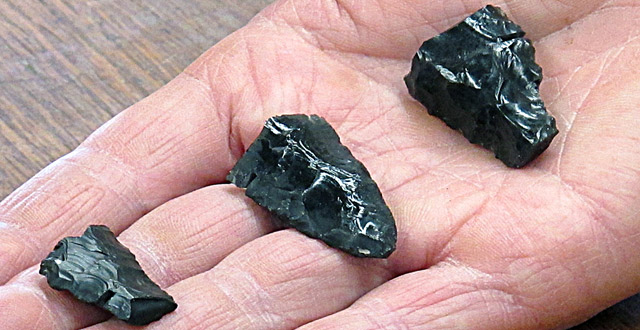Archaeologists excavating in Oregon’s Paisley Caves have found evidence that Western Stemmed projectile points – darts or thrusting spearheads – were present at least 13,200 years ago during or before the Clovis culture in western North America.

Bases of three Western Stemmed projectile points are shown in the hand of University of Oregon archaeologist Dr Dennis Jenkins (Jim Barlow)
The Paisley Caves are in the Summer Lake basin near Paisley, about 220 miles southeast of Eugene on the east side of the Cascade Range. The complex includes eight westward-facing caves, all wave-cut shelters, on the highest shoreline of pluvial Lake Chewaucan, which rose and fell in periods of greater precipitation during the Pleistocene, or last glacial period.
The results, published in a paper in the July 13 issue of Science, are based on 190 radiocarbon dates of artifacts, coprolites, bones and sagebrush twigs meticulously removed from well-stratified layers of silt in the ancient caves.
“Absent from the Paisley Caves,” said the project’s lead researcher Dr Dennis Jenkins of the University of Oregon’s Museum of Natural and Cultural History, “is diagnostic evidence of the Clovis culture such as the broad, concave-based, fluted Clovis projectile points.”
“The radiocarbon dating of the Western Stemmed projectiles to potentially pre-Clovis times,” Dr Jenkins said, “provides new information in the decades-old debate that the two point-production technologies overlapped in time and may have developed separately. It suggests that Clovis may have arisen in the Southeastern United States and moved west, while the Western Stemmed tradition began, perhaps earlier, in the West and moved east.”
“One example,” he said, “is the discovery of Clovis points below Western Stemmed points at Hell Gap, Wyo. While this example suggests that Clovis was older in that location than Western Stemmed, the new Paisley Caves evidence indicates that Western Stemmed are at least the same age as Clovis (about 12,800-13,000 years old) in the northern Great Basin of Oregon – about 1,000 miles west of Hell Gap.”
At least three other Western sites – Cooper’s Ferry in Idaho and Nevada’s Smith Creek Cave and Bonneville Estates Rockshelter – also contain only Western Stemmed points in deposits of this age.
“From our dating, it appears to be impossible to derive Western Stemmed points from a proto- Clovis tradition,” Dr Jenkins explained. “It suggests that we may have here in the Western United States a tradition that is at least as old as Clovis, and quite possibly older. We seem to have two different traditions co-existing in the United States that did not blend for a period of hundreds of years.”
The origin of humans in the Americas has long suggested early migration out of Siberia and eastern Asia, very possibly across a temporary land bridge between Russia and Alaska. In more recent years, Dr Jenkins’ colleague Dr Jon Erlandson has been building evidence – a lot of it emerging from the Channel Islands off California – of a Late Pleistocene sea-going people following a “kelp highway” from Japan to Kamchatka, along the south coast of Beringia and Alaska, then southward down the Northwest Coast to California. Kelp forests are rich in seals, sea otters, fish, seabirds, and shellfish such as abalones and sea urchins.
The new study doesn’t address the routes early migrants may have taken, but the additional evidence found in the DNA of the coprolites continues to point to Siberia-east Asian origins.
“We continued to excavate Paisley Caves from 2009 through 2011,” the authors wrote in the paper. “To resolve the question of stratigraphic integrity, we acquired 121 new accelerator mass spectrometry radiocarbon dates on samples of terrestrial plants, macrofossils from coprolites, bone collagen and water soluble extracts recovered from each of these categories. To date, a total of 190 radiocarbon dates have been produced from the Paisley Caves.”
_______
Bibliographic information: Jenkins DL et al. 2012. Clovis Age Western Stemmed Projectile Points and Human Coprolites at the Paisley Caves. Science vol. 337 no. 6091 pp. 223-228; doi: 10.1126/science.1218443







